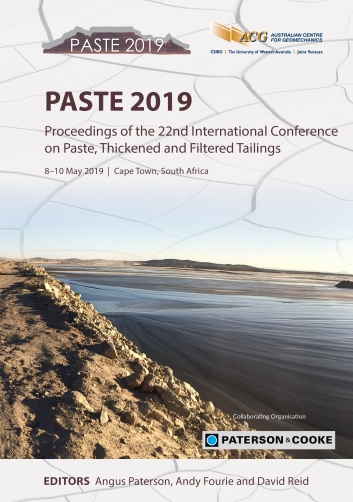A new waterproofing membrane for tailings ponds

|
Authors: Spagnoli, G; Clement, F; Dilnesa, BZ; Cao, FH; Feng, P |
DOI https://doi.org/10.36487/ACG_rep/1910_08_Spagnoli
Cite As:
Spagnoli, G, Clement, F, Dilnesa, BZ, Cao, FH & Feng, P 2019, 'A new waterproofing membrane for tailings ponds', in AJC Paterson, AB Fourie & D Reid (eds), Paste 2019: Proceedings of the 22nd International Conference on Paste, Thickened and Filtered Tailings, Australian Centre for Geomechanics, Perth, pp. 153-164, https://doi.org/10.36487/ACG_rep/1910_08_Spagnoli
Abstract:
Tailings are the materials left over after the process of separating the valuable fraction of ore from the gangue. Tailings ponds are engineered structures created using dams, berms and natural features such as valleys, hillsides or depressions. The pumping of tailings slurry into a pond allows the sedimentation of solids from the water. Tailings ponds can be highly toxic because they are used to store harmful waste made from separating minerals from rocks or the slurry produced from tar sands mining. To minimise contamination of underlying groundwater, high-density polyethylene (HDPE) liners are used. These liners are prefabricated sheets that are welded onsite to form a continuous waterproofing membrane that prevents the migration of contaminated water into the environment. Despite their widespread application, HDPE liners have inherent performance limitations, such as leakages at the location of welds, UV resistance, maintenance and repair. This paper considers a new type of sprayable reactive membrane as a waterproofing structure. Permeability tests with the Rowe cell, chemical and durability tests (interaction with water and leachates at different temperatures, oxidation and UV resistance tests) and mechanical tests (tensile strength tests, elongation tests, puncture tests) were performed and compared with conventional HDPE membranes for tailing ponds. Results showed that the new sprayable membrane has good performance comparable with the conventional HDPE membrane and it can be a very attractive solution for tailings ponds liners.
Keywords: tailings ponds, membrane, liners, laboratory tests, mechanical properties, chemical resistance
References:
Benson, CH, Zhai, H & Wang, X 1994, ‘Estimating hydraulic conductivity of compacted clay liners’, Journal of Geotechnical Engineering, vol. 120, no. 2, pp. 366–387.
BS 2004a, BS EN 14414:2004a, Geosynthetics. Screening Test Method For Determining Chemical Resistance For Landfill Applications, British Standards Institution, London.
BS 2004b, BS EN 14415:2004b, Geosynthetic Barriers. Test Method For Determining The Resistance To Leaching, British Standards Institution, London.
BS 2005, BS EN 14575:2005, Geosynthetic Barriers. Screening Test Method For Determining The Resistance To Oxidation, British Standards Institution, London.
BS 2015, BS ISO 34-1:2015(en) Rubber, Vulcanized Or Thermoplastic - Determination Of Tear Strength - Part 1: Trouser, Angle And Crescent Test Pieces, British Standards Institution, London.
Colombo, P & Colleselli F, 1996, Elementi di Geotecnica, 2nd edn, Zanichelli, Bologna.
DIN 2013a, DIN EN 13493:2013-11 Geosynthetische Dichtungsbahnen - Eigenschaften, Die Für Die Anwendung Beim Bau Von Deponien Und Zwischenlagern Für Feste Abfallstoffe Erforderlich Sind, Beuth Verlag GmbH, Berlin.
DIN 2013b, DIN EN 1844:2013-08 Abdichtungsbahnen - Verhalten Bei Ozonbeanspruchung - Kunststoff- Und Elastomerbahnen Für Dachabdichtungen, Beuth Verlag GmbH, Berlin.
Dickinson, SS & Brachman, RI 2008, ‘Assessment of alternative protection layers for a geomembrane - geosynthetic clay liner
(gm-gcl) composite liner’, Canadian Geotechnical Journal, vol. 45, no. 11, pp. 1594–1610.
Environmental Protection Authority Victoria 2015, Siting, Design, Operation and Rehabilitation of Landfills,
European Union Council Directive 1999, Council Directive 1999/31/EC 1999 of 26 April 1999 on the landfill of waste, Official Journal of the European Communities,
Head, KH 1985, Manual of Soil Laboratory Testing - Volume 3: Effective Stress Test, 3rd edn, Whittles Publishing, Caithness.
Koerner, RM 2012, Designing with Geosynthetics, 6th edn, Xlibris Publishing Co, Bloomington.
Premchitt, J, Ho, KS & Evans, NC 1995, Conventional and CRS Rowe Cell Consolidation Test on Some Hong Kong Clays, Geo Report No. 55, Geotechnical Engineering Office, Civil Engineering Department, Hong Kong viewed 4 September 2018,
Rowe, PW & Barden, L 1966, ‘A new consolidation cell’, Géotechnique, vol. 16, no. 1, pp. 162–170.
Rubinos, D, Spagnoli, G & Barral, MT 2015, ‘Assessment of bauxite refining residue (red mud) as a liner for waste disposal facilities’, International Journal of Mining, Reclamation and Environment, vol. 29, no. 6, pp. 433–452.
Shackelford, CD, Sevick, GW & Eykholt, GR 2010, ‘Hydraulic conductivity of geosynthetic clay liners to tailings impoundment solutions’, Geotextiles and Geomembranes, vol. 28, no. 2, pp. 149–162.
Spagnoli, G, Fernández-Steeger, T, Feinendegen, M, Stanjek, H & Azzam, R 2010, ‘The influence of the dielectric constant and electrolyte concentration of the pore fluids on the undrained shear strength of smectite’, Soils and Foundation, vol. 50, no. 5, pp. 757–763.
US EPA 1974, An Evaluation of Tailings Ponds Sealants, EPA 660/2-74-065, Corvallis.
US EPA 1994, EPA 530-R-94-038 Technical Report - Design and Evaluation of Tailings Dams, U.S. Environmental Protection Agency, Washington, viewed 4 September 2018,
© Copyright 2025, Australian Centre for Geomechanics (ACG), The University of Western Australia. All rights reserved.
View copyright/legal information
Please direct any queries or error reports to repository-acg@uwa.edu.au
View copyright/legal information
Please direct any queries or error reports to repository-acg@uwa.edu.au


